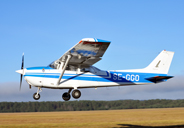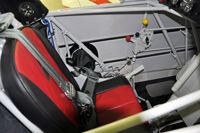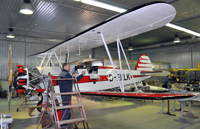2016
Cessna-172 Departure / 2016 12 01 /
   |
   |
TWO PLANES - TWO FATES: ANBO II & PIPER PA-18 / 2016 11 04 /
   |
The ANBO II was a parasol-wing monoplane aircraft built in Lithuania in 1927 as a pilot trainer for the Army designed by Antanas Gustaitis. It was written off in a crash in 1934.
ANBO II was rebuilt by ANBO Eskadrilė ( ANBO Squadron ) - a group of aviation enthusiasts, gathered together to restore Antanas Gustaitis designed aircraft ANBO.
Antanas Gustaitis (March 26, 1898 – October 16, 1941) was an officer in the Lithuanian Armed Forces who modernized the Lithuanian Air Force. He was the architect or aeronautical engineer who undertook the task to design and construct several military trainers and reconnaissance aircraft.
He studied at the Institute of Engineering and School of Artillery in Petrograd. After joining the Lithuanian Army in 1919, he graduated from the School of Military Aviation as a Junior Lieutenant in 1920.
Between 1925 and 1928, Gustaitis studied aeronautical engineering in Paris. After his graduation he returned to Lithuania, and was promoted to deputy Commander-in-Chief of Military Aviation and made chief of the Aviation Workshop in Kaunas. During this time, he reorganized the workshop and expanded its capability to repair aircraft as well. The nine different types aircraft he designed testing and organizing of their serial production were named ANBO, an acronym for "Antanas Nori Būti Ore" which means "Antanas wants to be in the air".
After Lithuania's occupation by the Soviet Union and the dissolution of the Lithuanian Army, he was a lecturer at Vytautas Magnus University, but fearing arrest he attempted to flee to Germany in 1941. He was caught attempting to cross the border on 4 March, arrested, and taken to Moscow where he was shot on the 16 October.
More facts about Antanas Gustaitis - here.
Piper PA-18 is a two-seat, single-engine monoplane introduced in 1949 by Piper Aircraft.
William Thomas Piper Sr. (January 8, 1881 - January 15, 1970) was an American airplane manufacturer, aviation businessman, oil industry businessman, and engineer. He was the founding president of the Piper Aircraft Corporation and led the company 1929 - 1970.
Piper realized that aircraft sales were directly related to the number of people who knew how to fly. So he set up a flying school in Lock Haven, Pennsylvania, at his manufacturing plant adjacent to the Lock Haven airport. Students who wanted to learn to fly paid their transportation, lodging and meals and Piper taught them to fly for $1 an hour which included the cost of the airplane and instructor. This low instruction cost also applied to his employees. At one time one out of every 90 persons in Lock Haven held a pilot’s license. It had a positive impact on the business because as long as the kids wanted to fly, they would build a good product.
During the Depression, Piper invested in designing and building low-cost airplanes. The most popular, the Piper Cub, cost only $1,325 with free flying lessons. Established the Piper Aircraft Corporation in 1937 and by 1940 Piper dominated the light plane field.
In World War II the first Piper L-4 went into combat during the invasion of North Africa. Throughout World War II, more than 5,000 Cubs were used in training, observation, artillery-spotting, patrol, and ambulance roles and served in every campaign on every front.
After World War II, he added various lines of the Cub to the military, corporate and general aviation fields. “Family Cruiser” is added to the pre-war “Cub” and “Cruiser”, followed by the “Super Cruiser”. Then, as the post war boom fade, the low-cost, stripped-down “Vagabond” was added to spur sales. Soon the Piper “Pager” was introduced to the line, as is the popular “Super Cub”, which replaced the old faithful Cub after 20,000 had been built.
Piper PA-18 was overhauled by us.
RV-6 Departure / 2016 10 12 /
   |
Silence Twister Elektro. / 2016 09 21 /
One of our last projects - Silence Twister Elektro. Some reading about the aircraft ( german language ) here.
The current issue of "Aerokurier" has an article about the Silence Twister. It covers aerobatics in ultra light aircraft as performed by Peter Wells und Chris Burkett with their Twisters. The magazine ( german language ) can be ordered on the magazine website.
   |
| GENERAL CHARACTERISTICS | |||
|---|---|---|---|
| Crew: | 1 | ||
| Length: | 7.50 m | Loaded weight: | 420 kg |
| Wingspan: | 7.50 m | Empty weight: | 310 kg |
| Powerplant: | 1,425-hp Wright Cyclone R-1820-86 radial piston engine | ||
| PERFORMANCE | |||
| Max. speed (Vne): | 299 km/h | ||
| Maneuvering speed (Va): | 180 km/h | Rate of climb at gross Wt.: | 6.5 m/s | Load factor: | +6/-4 |
Last week / 2016 08 22 /
   |
   |
Returning home to sunny Sweden / 2016 08 16 /
   |
Summer / 2016 08 10 /
   |
Last Month / 2016 06 05 /
   |
YAK-55 Green World / 2016 03 15 /
   |
Focke-Wulf Fw 44 Stieglitz / 2016 02 10 /
   |
The Focke-Wulf Fw 44 is a 1930s German two-seat biplane known as the Stieglitz ("Goldfinch"). It was produced by the Focke-Wulf company as a pilot training and sport flying aircraft. The Stieglitz was developed by Kurt Tank. It was also eventually built under license in several other countries.
The Fw 44 was designed as a biplane with conventional layout and straight, non-tapered wings. Its two open cockpits were arranged in tandem, and both cockpits were equipped with flight controls and instruments. The Fw 44 had fixed tailwheel landing gear. It employed ailerons on both upper and lower wings. It did not use flaps. It was flown with a Siemens-Halske Sh 14 radial engine.
| GENERAL CHARACTERISTICS | |||
|---|---|---|---|
| Crew: | two, student and instructor | Wingspan: | 9.00 m ( 29 ft 6 in ) |
| Length: | 7.30 m ( 23 ft 11 in ) | Height: | 2.80 m ( 9 ft 2 in ) |
| Empty weight: | 565 kg ( 1.243 lb ) | Loaded weight: | 770 kg ( 1.694 lb ) |
| Powerplant: | 1 × Siemens Sh A-4 7-cylinder radial engine, 118 kW (160 hp) at 2,100 rpm | ||
| PERFORMANCE | |||
| Max. speed: | 185 km/h ( 115 mph ) | ||
| Rate of climb: | 17 m/s ( 56 ft/s ) | Range: | 550 km ( 340 mi ) | Ceiling: | 3.900 m ( 12.790 ft ) |
   |











